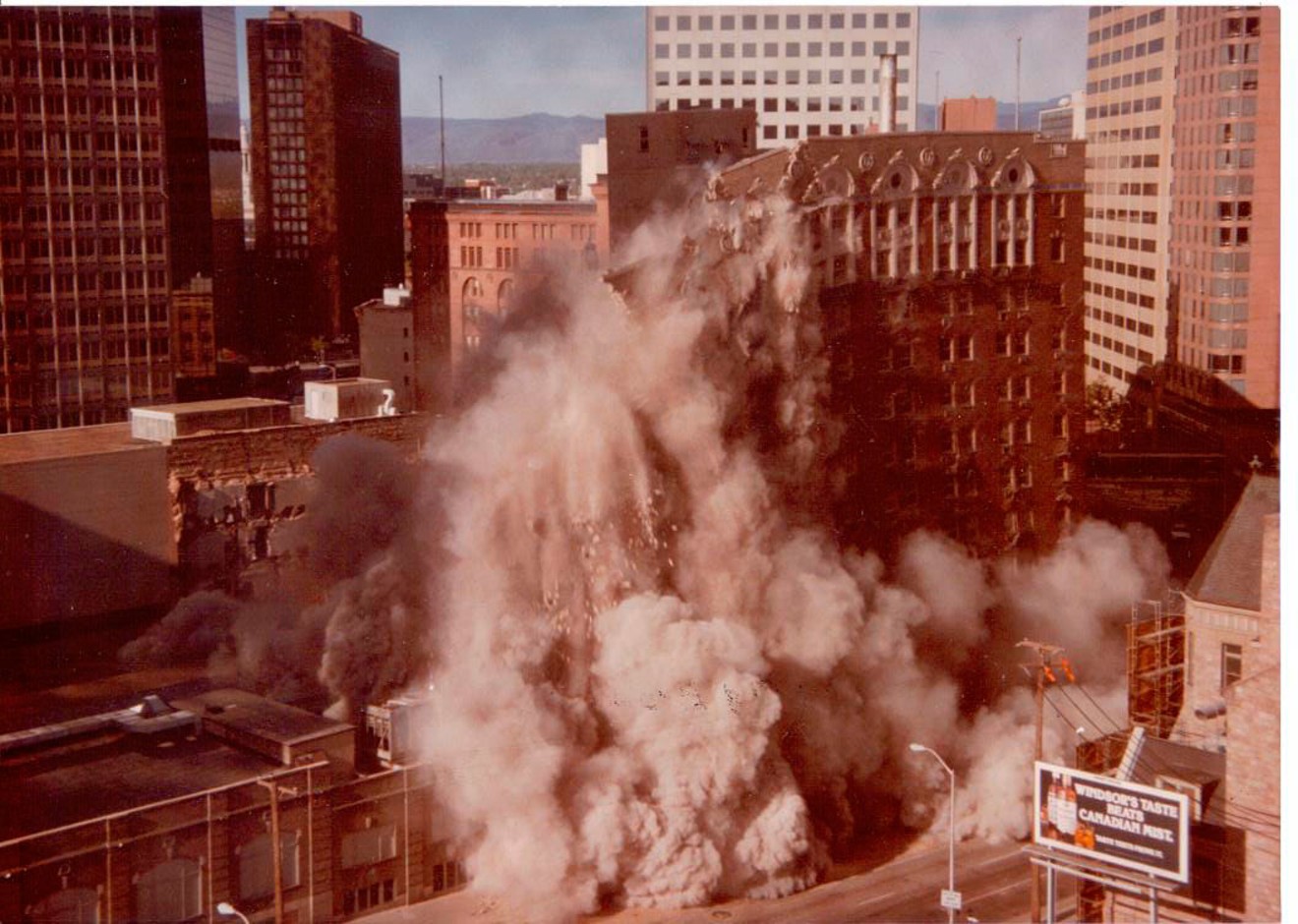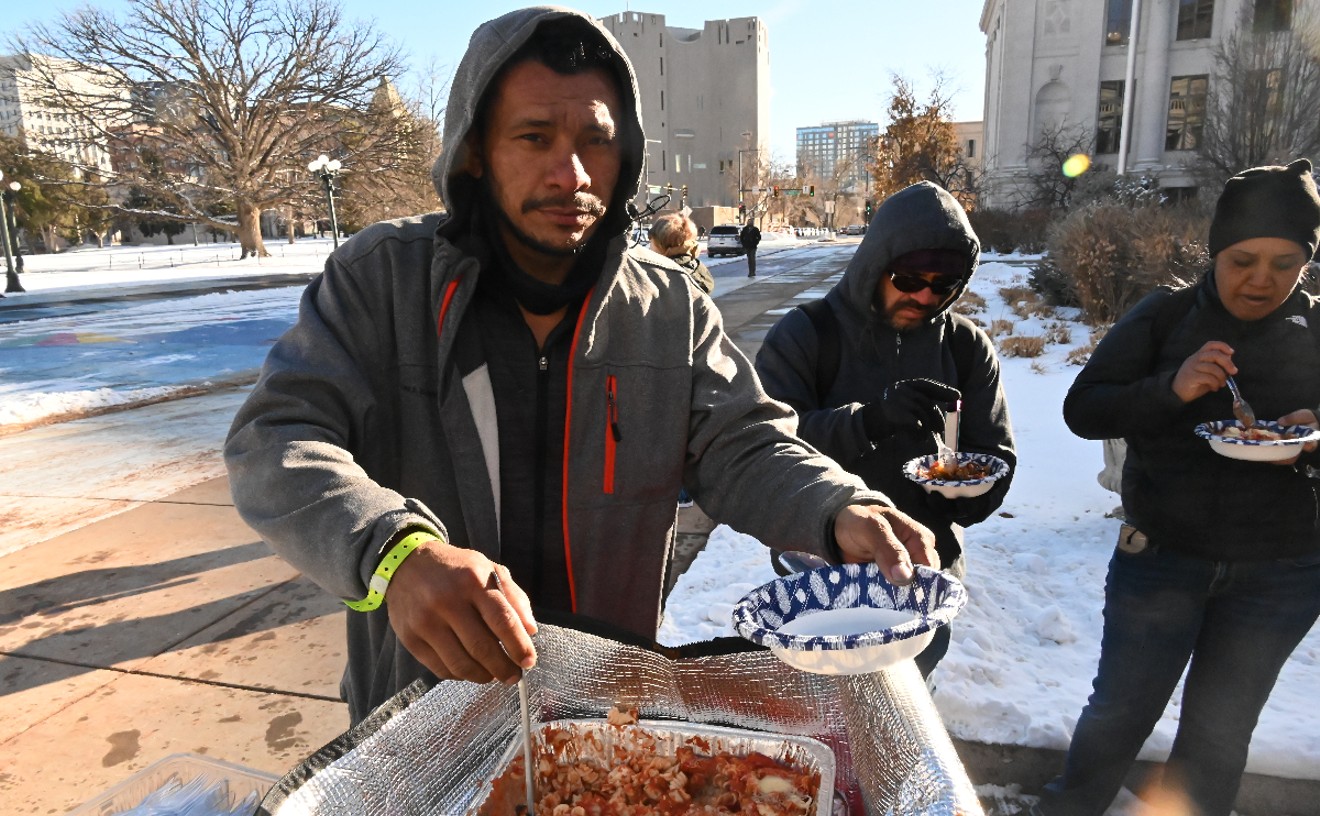But much of that stopped when Denver City Council approved the Denver Landmark Preservation Ordinance in March 1967, a year after the National Historic Preservation Act was enacted and two years after Dana Crawford began creating Larimer Square.
“Denver was right at the forefront,” says Annie Levinsky, executive director of Historic Denver Inc., which was founded three years after the ordinance was adopted. “We are tremendously fortunate that Denver’s leaders had the foresight to create the ordinance and the Landmark Preservation Commission. It protected and recognized a ton of buildings, places that would be lost — or we’d be losing right now.”
Especially now, as developers snap up every piece of property they can get their hands on, building up and out to the limits of the city’s zoning codes...and sometimes beyond.

Some of the buildings that Denver has lost were known more for their use than their aesthetics.
Denver Public Library
The commission has gained power over the past fifty years; in the beginning, it couldn’t designate a building as a landmark, just issue a one-year stay of demolition. But its role has evolved, and today Denver has 52 historic districts and 335 individual landmarks — “about 4 percent of the city,” Levinsky estimates — with about 6,600 structures saved over the past five decades.
“When you look at it, we saved a lot,” says Crawford. “But we have to be really, really careful. We’re going to have a lot more growth, and a demand for more density. People are going to have to get used to the idea of more density.” And fewer surface parking lots.
Historic Denver got its start with a victorious push to save the Molly Brown House, after Capitol Hill’s grand Moffat Mansion fell to the wrecking ball, and then it kept on pushing to protect historic structures, taking the campaign not just to the landmark commission, but also to the public: People needed to see what was at stake.
Still, not all of its efforts were successful. “We were still using a lot of buildings in downtown Denver well into the 1990s,” Levinsky says, citing Central Bank and the Zeckendorf Plaza. And the danger isn’t over yet.
“How do we hold on to the fabric of our city as we charge through this growth spurt?” she asks. “The Landmark Preservation Commission still has very viable tools, working tools, now paired with incentives at the state and federal level. We also recognize that we need to expand that toolbox, empower neighborhoods.”
And also to train people to recognize that some of the structures worth saving might not seem obvious at first. Buildings are most at risk when they are in their thirties or forties, she explains: “It’s a risky moment, before people can appreciate it as historic.”
Doors Open Denver, the annual celebration of this city’s notable structures, runs April 29 and April 30 this year; it’s an ideal time to get out and appreciate Denver’s architecture while you can. Historic Denver and Colorado Preservation Inc. will just build on the momentum in May, to coincide with National Historic Preservation Month: Historic Denver will resume its popular walking tours on May 1 and hold a cultural preservation forum on May 16; May 18 marks the 28th annual Dana Crawford and State Honor Awards Celebration. Find a complete list of events on the History Colorado website.
Historic Denver is also launching Assignment 2017, a contest that calls on photographers, amateur or not, to capture a favorite historic place, landmarked or not; get the details at historicdenver.org.
In the meantime, keep reading to see some of Denver’s legendary buildings and cultural icons that are no longer around to photograph, and four more that are still here, but very changed in purpose.
The 16th Street Mall has come a long way...but to where, exactly? In 1956, I.M. Pei designed the hyperbolic paraboloid building at the Zeckendorf Plaza right off 16th Street as the entrance to a department store, but it was a destination in its own right. In the summer, this was a sunny spot to hang, in the winter the site of a popular skating rink. But the building was in the way of what was considered progress in the early ’90s, and after a hard-fought fight, Fred Kummer, a St. Louis hotelier who wanted to build the Adam’s Mark, got the city’s permission to demolish the structure — and even some city funding for the project. What did Denver get in exchange? A lousy sculpture of ballet dancers and the lobby of what is now the downtown Sheraton.
On the rough-and-tough frontier, opera houses were considered symbols of civilization. Central City had one, Leadville had one, and Horace Tabor gave Denver a great one: the Tabor Grand Opera House, at 16th and Curtis streets. The stunning structure opened in 1881, a dozen years before Tabor lost his fortune in the Silver Crash of 1893. (He lost his shot at a political career after he left wife Augusta for Baby Doe.) In 1961, the Tabor Grand itself came crashing down, one of the first losses in a decade that disappeared many historic buildings from downtown Denver, replacing them with surface parking lots…and in the process paving the way for the preservation movement.
Before the turn of the last century, Mary Elitch created an oasis of culture on the far northwest edge of Denver, with lovely gardens, picnic grounds and a theater. Over the years, Elitch Gardens added amusement park rides and other attractions that made it one of Denver’s most popular gathering spots. But it also turned into a prime spot for a pioneering new urbanism development, and in 1989 Denver voters agreed to pay $14 million for infrastructure changes that would allow Elitch’s to move down to the Platte Valley. The campaign slogan? “Vote for Elitch’s: It’s Denver.” In 1996, Elitch’s was sold to Six Flags; it’s since changed hands again, and is now owned by a group headed by Stan Kroenke. The original Elitch Theatre still stands off West 38th Avenue.
Developers are mining Jefferson Park for property gold these days, but for decades, the money machine in this part of northwest Denver was Baby Doe’s Matchless Mine, a restaurant at 2520 West 23rd Avenue that opened in 1978. The theme paid homage to Baby Doe Tabor, the sweetheart of Central City who captured the heart (and wallet) of Horace Tabor. She died, penniless, at the Matchless Mine, which still stands outside Leadville. Her namesake restaurant and a companion, the Chile Pepper, which stood on the bluff overlooking Denver, were demolished exactly a decade ago, replaced by massive apartment complexes that were forerunners of things to come in Denver.
When the William Bowman-designed Cosmopolitan Hotel opened in 1926 at 1760 Broadway, it was billed as the “most complete” hotel in Denver, thumbing its upstart nose at the Brown Palace across the street. But the Brown got the last laugh; in 1984, the Cosmopolitan was demolished, taking Denver’s first tiki bar with it. Today, that block of Broadway is becoming a fortress of high-rises.
At the same time that adults were hanging out at the Cosmopolitan, kids were flocking to Celebrity Sports Center, at 888 South Colorado Boulevard. The ultimate entertainment center opened in 1960, the brainchild of Walt Disney and other heavy-hitting Hollywood investors. After a last round of bowling, a last swoosh down the water slide, Celebrity closed in 1994. Today the site is home to a Home Depot.
Like Zeckendorf Plaza, the Charles Boettcher School was a loss that preservationists have yet to forget, much less forgive. Famed architect Burnham Hoyt designed the building at 1900 Downing Street in the International Style in 1938. The purpose of this modernist masterpiece was as groundbreaking as its architecture: It initially opened as the Crippled Children’s School, a public school designed to provide an education for children with disabilities before that population was mainstreamed. Ironically, Denver Public Schools sold off the property in the ’90s, when Children’s Hospital wanted to expand; instead, Children’s wound up creating a complex at Fitzsimons. But by then, the Boettcher School was gone.
The I-70 viaduct through north Denver is getting all the attention these days, but Denver was once full of even more rickety viaducts that spanned the railroad tracks and the river. Many of these came tumbling down in the ’80s and ’90s, including the 20th Street viaduct, which had led from downtown across the railyards to Highland, then a sleepy working-class area. Today a far sturdier structure takes off from downtown at Blake Street, past Coors Field to booming LoHi, in the process crossing over the Bottoms, a once-empty expanse of the Platte Valley where today every square foot has been claimed for a development project. And so it grows...
Now for four buildings with legendary pasts that you can still see in Denver:
The Webber Show, “a motion picture house of original and attractive design, decorated and furnished in cubist style,” according to the Rocky Mountain News, opened at 119 South Broadway exactly a century ago. Over the years, though, it devolved into pictures of a different sort: When the Show closed for good a decade ago, it was Kitty’s South, a porn palace. When new owners bought the place, they applied for a “certificate of non-historic status” — which, if granted by the city, allows for the demolition of a building. But while their request was approved, they’ve saved as much as they could of the structure, even scrounging up some of its original features from storage in the bowels of the building. And soon the curtain will rise on the theater’s next chapter: as Archetype Distilling.
The long, low art-deco building at 1080 East Colfax Avenue was a neighborhood shopping center right on a convenient streetcar line when it opened in 1932, but by the time it became Smiley’s in 1979, the street had gotten a lot grittier — which made it just the right spot for a 24-hour laundromat. Always a favorite hangout with late-night locals, Smiley’s gained national notoriety in the ’80s, when Today honored it as the world’s largest laundromat. But now the building is washed up and hung out to dry: Smiley’s closed in 2013, and despite Historic Denver’s efforts to save at least part of the structure, the new owners plan to replace it with a seven-story apartment complex.
When this Renaissance Revival-style building at 1635 Court Place was built in 1910, it featured fancy ornamental brick and a cornice. But its greatest asset was Duffy’s Shamrock Bar, a watering hole that was a go-to spot for the working class for over three decades, a place to grab a nightcap after the nearby hoity-toity Brown Palace closed. Duffy’s closed late and opened early, and its St. Patrick’s Day celebrations were the stuff of legend. Sadly, in 2006 Duffy’s poured its last drink: The Lombardi brothers sold the building to the owners of the adjacent 56-story Republic Plaza, who planned to develop the property. So far, though, there’s been no action, and Duffy’s still stands, an empty shell that makes us thirst for another round.
Clint Eastwood shlepped here. This three-story structure at 1201-1225 East Colfax Avenue started out in 1905 as a commercial building with a Mediterranean Revival feel, complete with a tile roof and wrought-iron balconies. But when Denver’s Sultan of Striptease turned it into Sid King’s Crazy Horse Bar, it was what was inside the place that counted: plenty of topless talent. The establishment was colorful enough to hold its own against an orangutan, Eastwood’s co-star, in the 1978 film Every Which Way but Loose. Five years later, though, King closed the joint, and went on to run a drive-up shoe-repair spot. Years later, the home of his legendary club was polished into the Irish Snug.
What Denver building do you miss? What would you hate to lose?
























